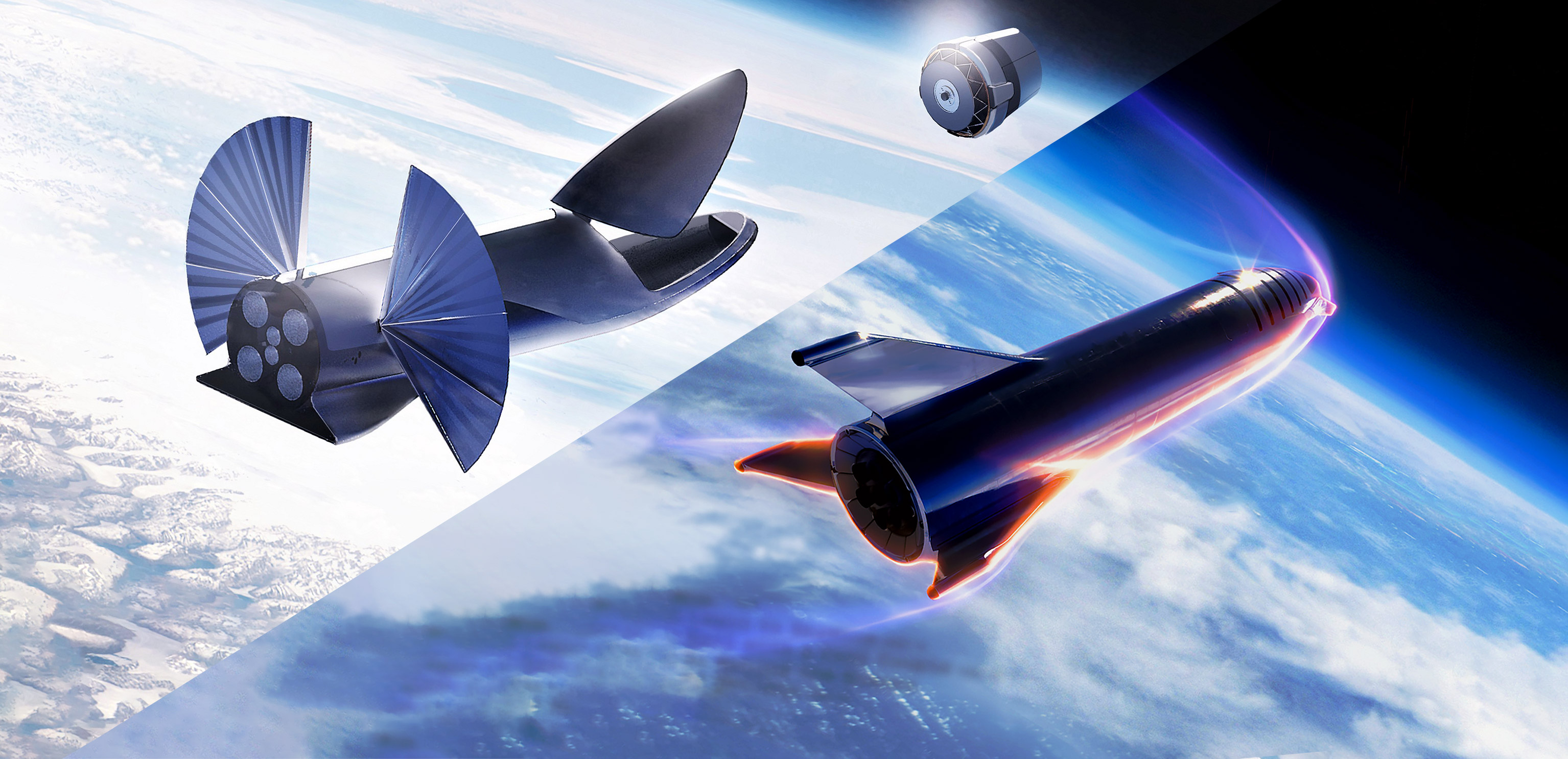

News
SpaceX’s Starship could launch secret Turkish satellite, says Gwynne Shotwell
According to SpaceX COO/President Gwynne Shotwell and a Turkish satellite industry official, Starship and Super Heavy may have a role to play in the launch of Turksat’s first domestically-procured communications satellite.
Per Shotwell’s specific phrasing, this comes as a bit of a surprise. Built by Airbus Defense and Space, SpaceX is already on contract to launch Turksat’s 5A and 5B communications satellites as early as Q2 2020 and Q1 2021, respectively. The spacecraft referred to in the context of Starship is the generation meant to follow 5A/5B: Turksat 6A and any follow-on variants. Turksat’s 6-series satellites will be designed and manufactured domestically rather than procured from non-Turkish heavyweights like Airbus or SSL. However, the Turksat 6A satellite’s current baseline specifications would make it an extremely odd fit for a launch vehicle as large as Starship/Super Heavy.
Curiously, in written statements to Turkish media outlets, Turkish Aerospace Industries (TAI) referred to a “Turksat 6A2” satellite for the first time ever. Prior to comments made at the Satellite 2019 conference, Turksat’s prospects beyond 5A/5B were simply referred to as “Turksat 6A”, a ~4300 kg (9500 lb) domestically-built communications satellite scheduled for completion no earlier than the end of 2020. Turksat 5A and 5B will both be approximately 4500 kg (9900 lb), well within the capability of the flight-proven Falcon 9 rockets they are expected to launch on.
Why, then, might Starship “[potentially] work for the next Turksat project”, as suggested by Shotwell? Referring to what Turksat GM Cenk Sen then described as “6A2”, Shotwell noted that the satellite would be “quite a large, complex satellite.” While undeniably massive relative to almost anything else, the 4300-kg Turksat 6A is actually in the middle of the road (maybe even on the smaller side) relative to most geostationary communications satellites built and launched in the last few years.


We’re gonna need a bigger speculation…
SpaceX COO and President Gwynne Shotwell would know this as intimately as anyone, given her essential role at the head of the launch services provider. Most recently, SpaceX used Falcon Heavy to launch Arabsat 6A (6500 kg/14,300 lb) to a uniquely high transfer orbit of ~90,000 km (56,000 mi). In the second half of 2018, Falcon 9 was also tasked with launching Telstar 18V (7060 kg/15,560 lb) and 19V (7076 kg/15,600 lb) to geostationary transfer orbits (GTO), with 19V technically becoming the heaviest commercial communications satellite ever launched.
SpaceX is also just a few days away from launching 60 Starlink test satellites, reportedly set to become the company’s heaviest payload ever with a mass greater than ~13,000 kg (30,000 lb). Put simply, SpaceX is about as familiar as one can possibly get with not only launching – but even building – truly massive and complex satellite payloads.



In short, it appears that “Turksat 6A2” may refer to an extremely ambitious follow-on to Turksat 6A (perhaps 6A1?). To warrant the use of Starship over the then highly-proven and well-paved Falcon 9 or Heavy, Turksat 6A2 would indeed have to be what Shotwell referred to as “quite a large, complex satellite”. In a recoverable configuration, Falcon 9 is capable of placing about 5500-6000 kg into a full GTO. Falcon Heavy allows for 8000-10000 kg, with the latter option assuming that all three boosters land on drone ships. Steel Starship’s performance – with or without tanker refueling – is effectively an unknown quantity at this point in time, although SpaceX CEO Elon Musk says more Starship info will be provided this year at a dedicated June 20th event.
Aside from questions of payload performance of Starship/Super Heavy relative to Falcon 9/Heavy, it’s unclear when the next-gen SpaceX rocket will actually be ready to start launching commercial payloads. Back in December 2018, Musk estimated that Starship had a 60% chance of reaching orbit by the end of 2020, with confidence on the rise as the company transitioned BFR’s structure from carbon composites to stainless steel. Four months after that estimate, a low-fidelity Starship prototype – nicknamed Starhopper – successfully completed two Raptor-powered test fires, straining a few feet into the air against large tethers. Meanwhile, Raptor testing continues in McGregor, Texas, while progress is also being made on what is said to be the first orbit-capable Starship prototype a few thousand feet from Starhopper.
A long path to orbit
Before SpaceX can begin orbital launch attempts with Starship, the company will need to build a new launch complex (or develop a floating launch platform), complete with processing and integration facilities also built from the ground up. Additionally, at least one massive Super Heavy booster will be needed for Starship to deliver more than just itself to orbit. Starship’s unprecedented metallic heat shield will need to be made flight-ready, while a minimum of 38 Raptor engines will need to be built and tested. In short, a huge amount of work needs to be done before Starship and its associated facilities will be capable of launching high-value customer payloads.

In other words, any prospective Cargo Starship customers will necessarily be shopping for launches in 2021-2022 at the absolute earliest. According to TAI’s Sen, SpaceX and its Starship vehicle will be just “one of the candidate[s]” eligible to compete for the Turksat 6A2 launch contract, hinting that these new comments are just the first of many more to come.
Check out Teslarati’s Marketplace! We offer Tesla accessories, including for the Tesla Cybertruck and Tesla Model 3.
News
Tesla Robotaxi has already surpassed Waymo in this key metric
Tesla Robotaxi has already overtaken Waymo in Austin in one key metric, but there’s still more work to do.

Tesla Robotaxi has already surpassed Waymo in one extremely important key metric: size of service area.
Tesla just expanded its service area in Austin on Monday morning, pushing the boundaries of its Robotaxi fleet in an interesting fashion with new capabilities to the north. Yes, we know what it looks like:
🚨 Tesla’s new Robotaxi geofence is…
Finish the sentence 🥸 pic.twitter.com/3bjhMqsRm5
— TESLARATI (@Teslarati) July 14, 2025
The expansion doubled Tesla Robotaxi’s potential travel locations, which now include the University of Texas at Austin, a school with over 53,000 students.
The doubling of the service area by Tesla has already made its travel area larger than Waymo’s, which launched driverless rides in October 2024. It became available to the public in March 2025.
According to Grok, the AI agent on X, Tesla Robotaxi’s current service area spans 42 square miles, which is five square miles larger than Waymo’s service area of 37 square miles.
Tesla Robotaxi (red) vs. Waymo geofence in Austin.
Much can be said about the shape… but the Robotaxi area is now ~3.9 mi² (10 km²) larger than Waymo’s!! pic.twitter.com/dVfh2ODxJC
— Robin (@xdNiBoR) July 14, 2025
The service area is one of the most important metrics in determining how much progress a self-driving ride-hailing service is making. Safety is the priority of any company operating a ride-hailing network, especially ones that are making it a point to use autonomy to deploy it.
However, these companies are essentially racing for a larger piece of the city or cities they are in. Waymo has expanded to several different regions around the United States, including Arizona and Los Angeles.
Tesla is attempting to do the same in the coming months as it has already filed paperwork in both California and Arizona to deploy its Robotaxi fleet in states across the U.S.
As the platform continues to show more prowess and accuracy in its operation, Tesla will begin to expand to new areas, eventually aiming for a global rollout of its self-driving service.
News
Tesla Megapacks arrive for massive battery replacing coal plant
Tesla Megapacks have started arriving on-site to the Stanwell Battery Project, just as Queensland prepares to wind down the Stanwell coal plant.
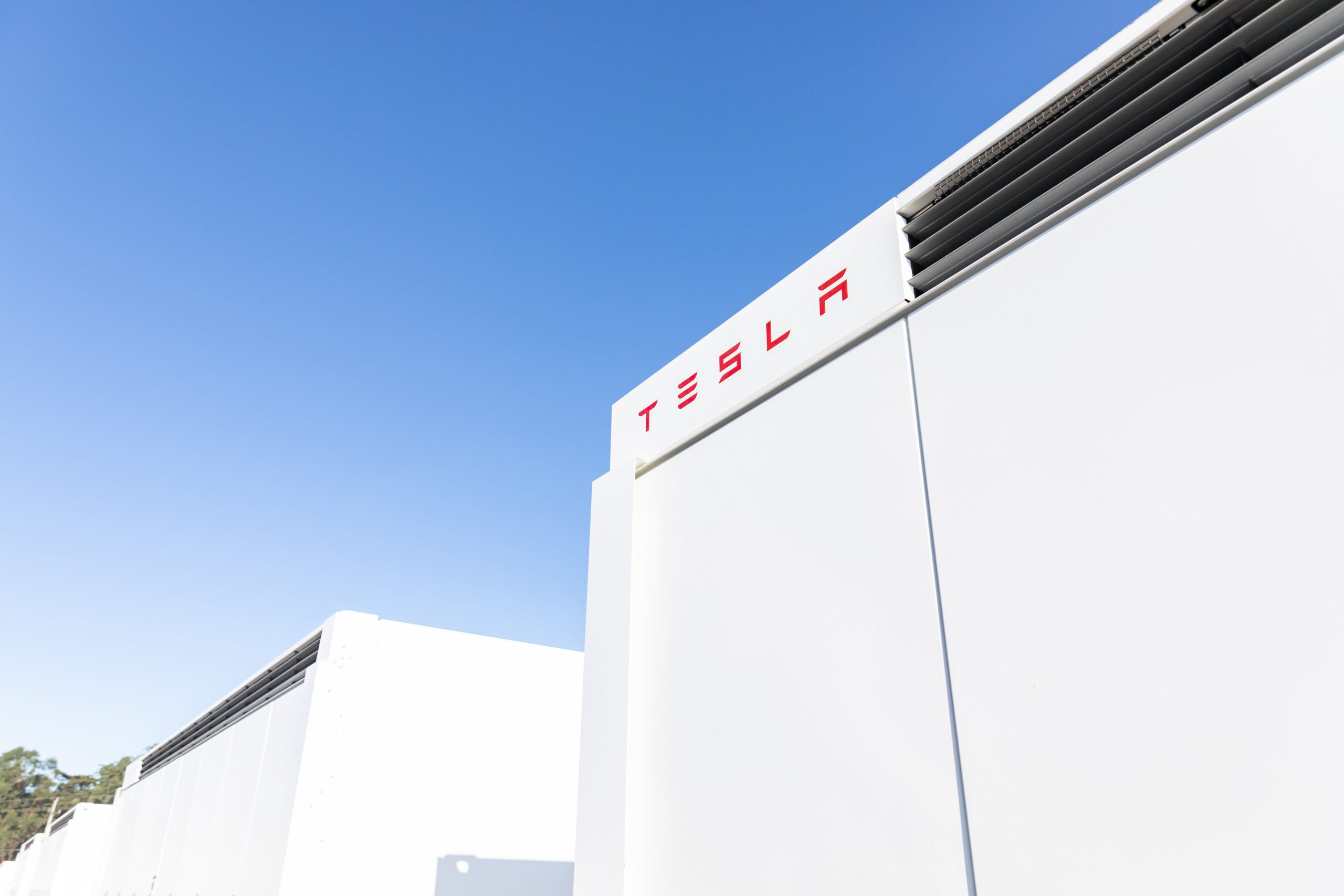
The first of over 300 Tesla Megapacks have arrived to the site of a massive battery energy storage system (BESS) being built in Australia, dubbed the Stanwell Battery Project after a coal plant it’s set to replace.
In a press release last week, the Stanwell Battery Project announced that the first Tesla Megapack 2XL units had arrived to the site, which is located outside of Rockhampton in Queensland, Australia. The project will eventually feature 324 Megapack units, set to arrive in the coming months, in order to support the 300MW/1,200MWh battery project.
“The Stanwell Battery is part of the diversification of our portfolio, to include cleaner and more flexible energy solutions,” said Angie Zahra, Stanwell Central Generation General Manager. “It is just one part of the 800 MW of battery energy storage capacity we have in our pipeline.
“Capable of discharging 300 MW of energy for up to four hours (1,200 MWh), our mega battery will be one of the largest in Queensland.”
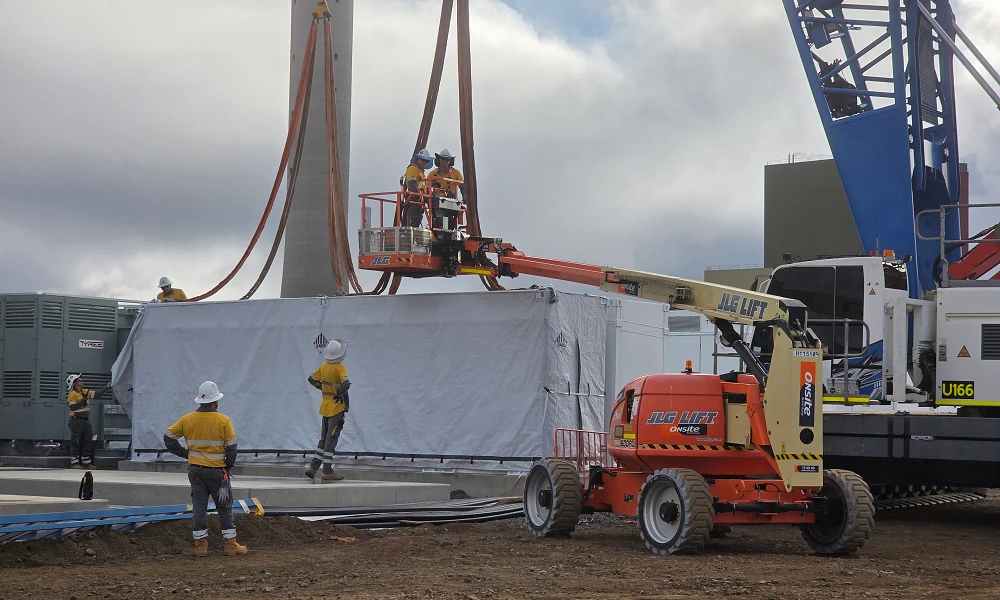
Credit: Stanwell
Did you know Tesla’s Lathrop facility churns out a Megapack every 68 minutes? That’s enough energy to power 3,600 homes for an hour per unit! ⚡️ pic.twitter.com/bG6fpHkB9O
— TESLARATI (@Teslarati) June 11, 2025
READ MORE ON TESLA MEGAPACKS: Tesla Lathrop Megafactory celebrates massive Megapack battery milestone
The state is working with government-owned company Yurika to facilitate construction, and the process is expected to create roughly 80 jobs. The project is expected to come fully online in May 2027, with initial commissioning of the Megapacks aiming for November 2025.
The Stanwell Battery is set to replace the nearby Stanwell coal generation plant, which the government is planning to wind down starting in 2026 as part of efforts to reach an 80 percent renewable energy generation ratio by 2035. Meanwhile, the government is also set to begin winding down the Tarong and Callide coal plants, while several other Megapack projects are being built or coming online. o ya
Tesla currently has two Megapack production facilities, located in Lathrop, California, in the U.S. and another that came online earlier this year in Shanghai, China. The Shanghai Megafactory shipped its first units to Australia in March, while both factories are expected to be capable of producing 10,000 Megapack units per year upon reaching volume production.
News
The Tesla Diner is basically finished—here’s what it looks like
The company first broke ground on the Diner, Drive-in, and Supercharger location in September 2023. Now, it has served one of its first internal customers.

Tesla has finally completed the construction of its highly anticipated Diner, Drive-in, and Supercharger in Los Angeles, and recent photos of the interior’s “retro-futuristic” style are making their way around the internet.
X user Brad Goldberg shared photos from the Tesla Diner site last Tuesday, depicting some of the Supercharger stalls, indoor and outdoor seating areas, multiple neon lights, and even an Optimus robot. Goldberg also noted that there had been a “flurry of activity on site” while he was snapping the photos last week, suggesting that the restaurant location could be getting close to opening.
The Tesla Diner also served one of its first internal customers in the past few days, as Elon Musk posted on X on early Monday morning that he had just finished up eating a meal at the site:
I just had dinner at the retro-futuristic Tesla diner and Supercharger.
Team did great work making it one of the coolest spots in LA!
The photos also show that the site is pretty much done, with some of them even showing vehicles charging at the charging stalls.
You can see some of the latest photos of the Tesla Diner below.

Credit: BradGoldbergMD | X
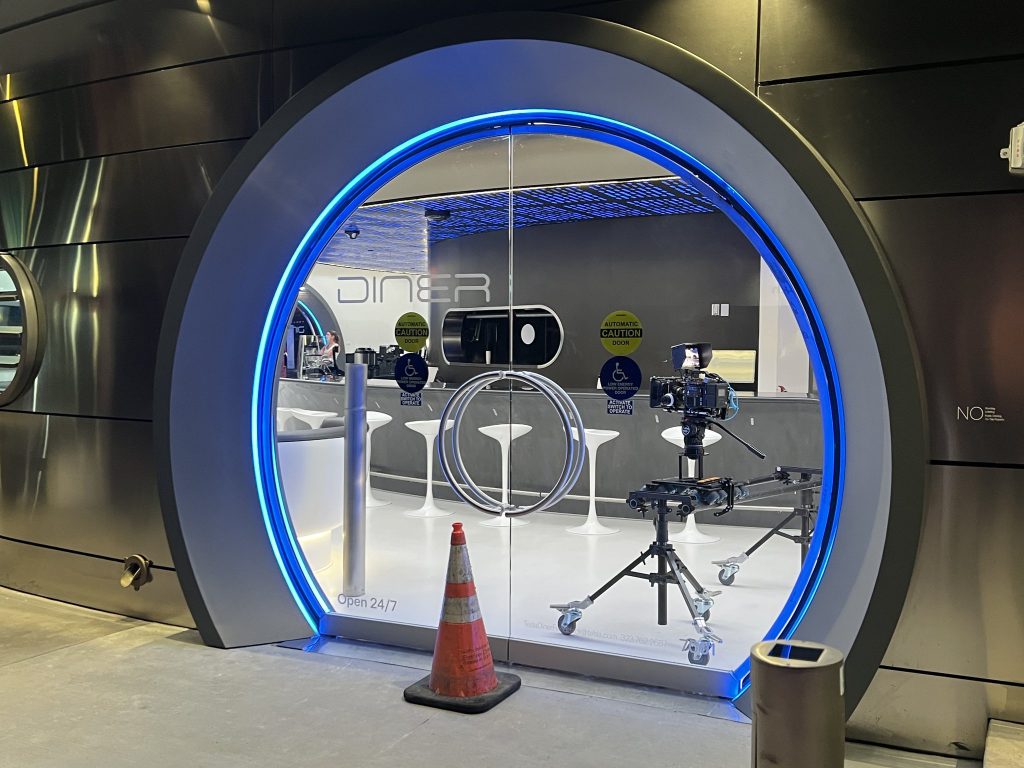
Credit: BradGoldbergMD | X

Credit: BradGoldbergMD | X
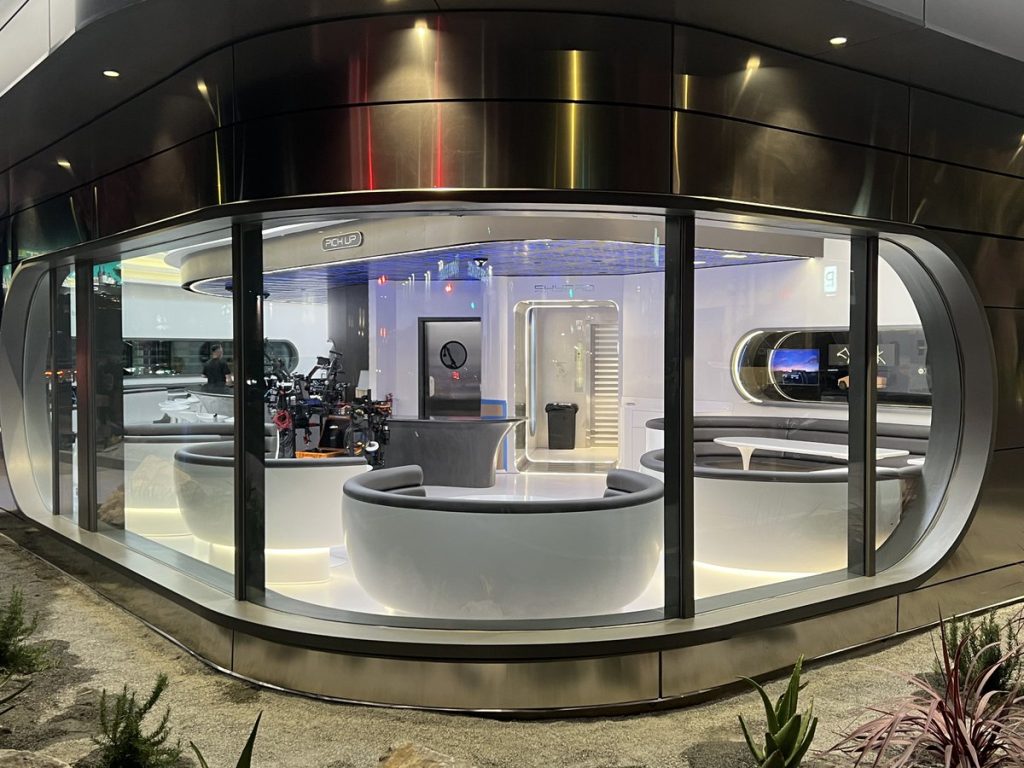
Credit: BradGoldbergMD | X

Credit: TeslaKing420 | X

Credit: TeslaKing420 | X
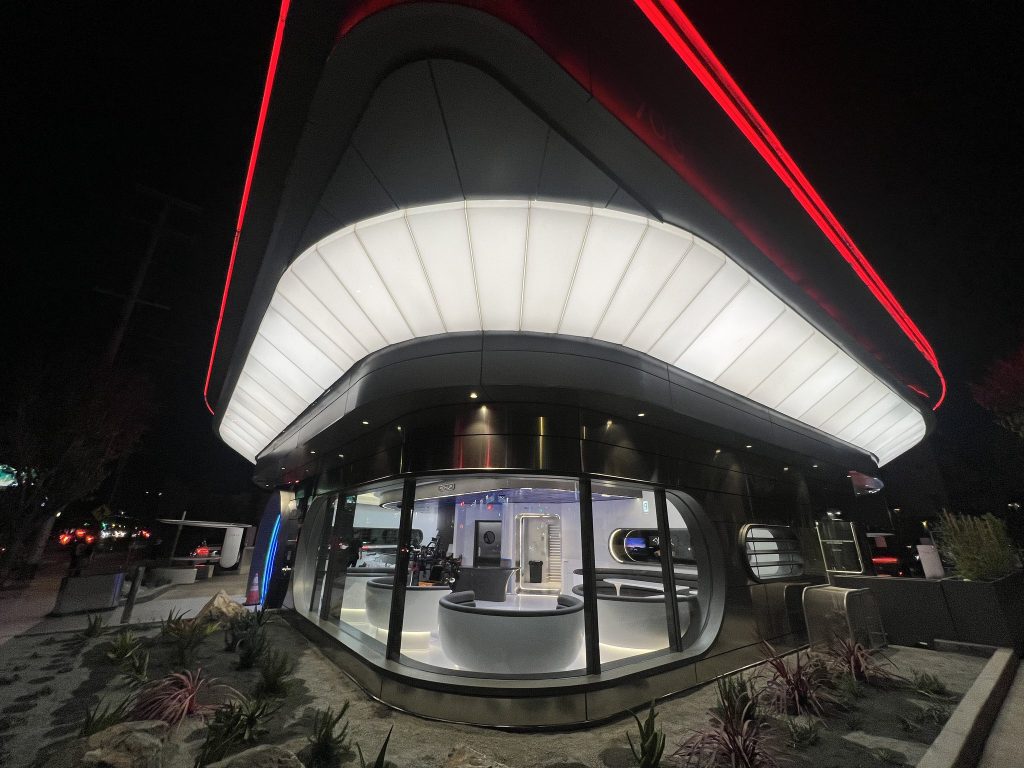
Credit: Brad Goldberg (via Sawyer Merritt on X)

Credit: Brad Goldberg (via Sawyer Merritt on X)

Credit: Brad Goldberg (via Sawyer Merritt on X)

Credit: Brad Goldberg (via Sawyer Merritt on X)

Credit: Brad Goldberg (via Sawyer Merritt on X)
READ MORE ON TESLA’S LA DINER: Tesla readies Drive-In Diner Supercharger for launch with app inclusion
When will the Tesla Diner open to external customers?
While it’s still not open to external customers yet, the news again suggests that the company could be close to an official opening date. Tesla first broke ground on the Diner in September 2023, after receiving a wave of building permit approvals throughout that year. Teslarati also covered much of the construction progress throughout last year, including when crews installed the first and second drive-in screens.
Located at 7001 West Santa Monica Boulevard, the idea was first discussed in 2018 by Musk and a few others on Twitter, featuring 1950s rock and roll, waiters on roller skates, and drive-in movie theater screens playing clips from some of history’s best movies. Notably, the photos of the front doors also show that the site will be open 24 hours a day, 7 days a week, whenever it does end up opening.
Tesla’s progress on Supercharger with diner, drive-in seen in aerial footage
-

 Elon Musk2 weeks ago
Elon Musk2 weeks agoTesla investors will be shocked by Jim Cramer’s latest assessment
-

 News2 days ago
News2 days agoTesla debuts hands-free Grok AI with update 2025.26: What you need to know
-

 Elon Musk4 days ago
Elon Musk4 days agoxAI launches Grok 4 with new $300/month SuperGrok Heavy subscription
-

 Elon Musk7 days ago
Elon Musk7 days agoElon Musk confirms Grok 4 launch on July 9 with livestream event
-

 News1 week ago
News1 week agoTesla Model 3 ranks as the safest new car in Europe for 2025, per Euro NCAP tests
-

 Elon Musk2 weeks ago
Elon Musk2 weeks agoxAI’s Memphis data center receives air permit despite community criticism
-

 News4 days ago
News4 days agoTesla begins Robotaxi certification push in Arizona: report
-

 News2 weeks ago
News2 weeks agoTesla sees explosive sales growth in UK, Spain, and Netherlands in June

















